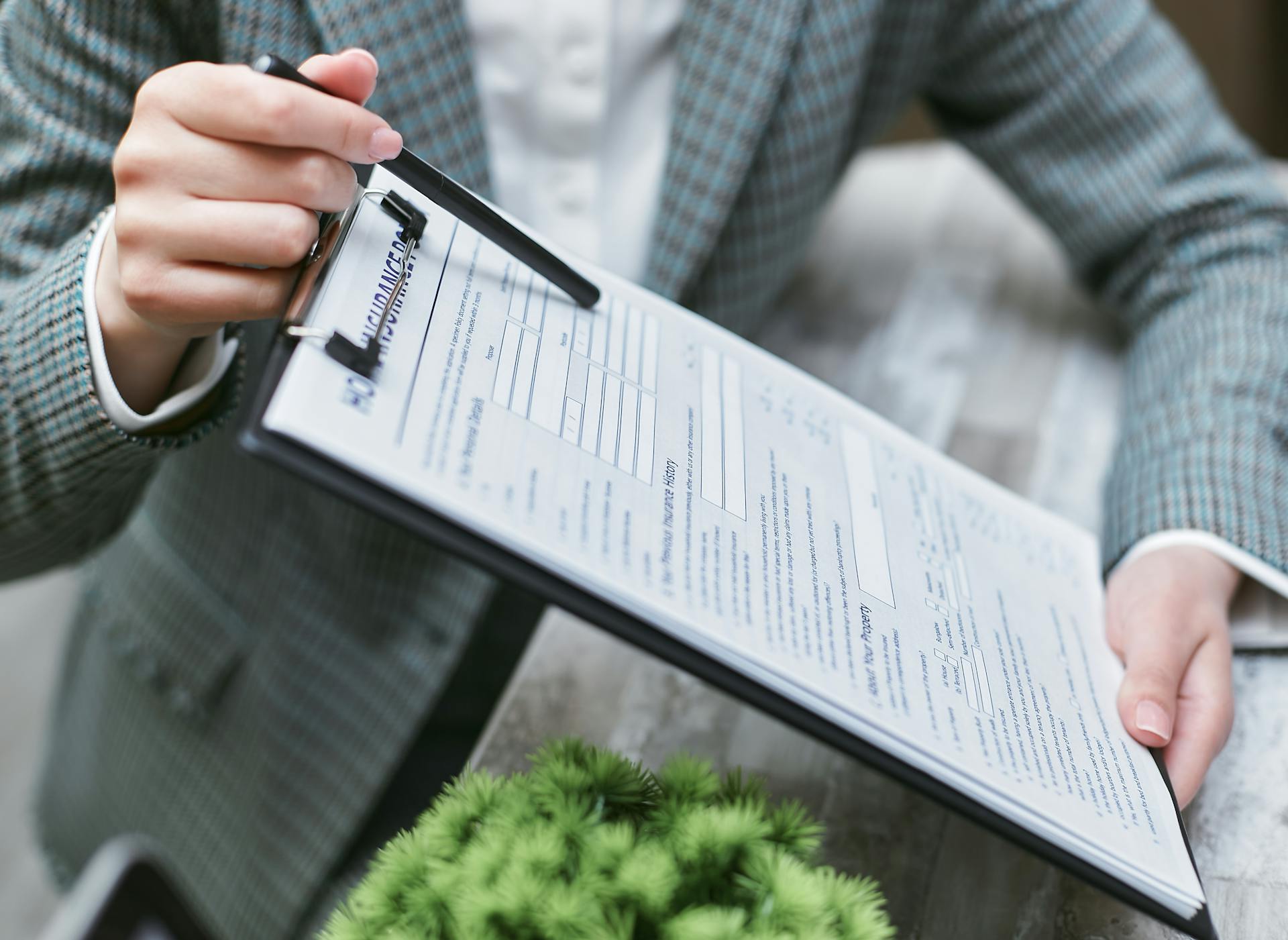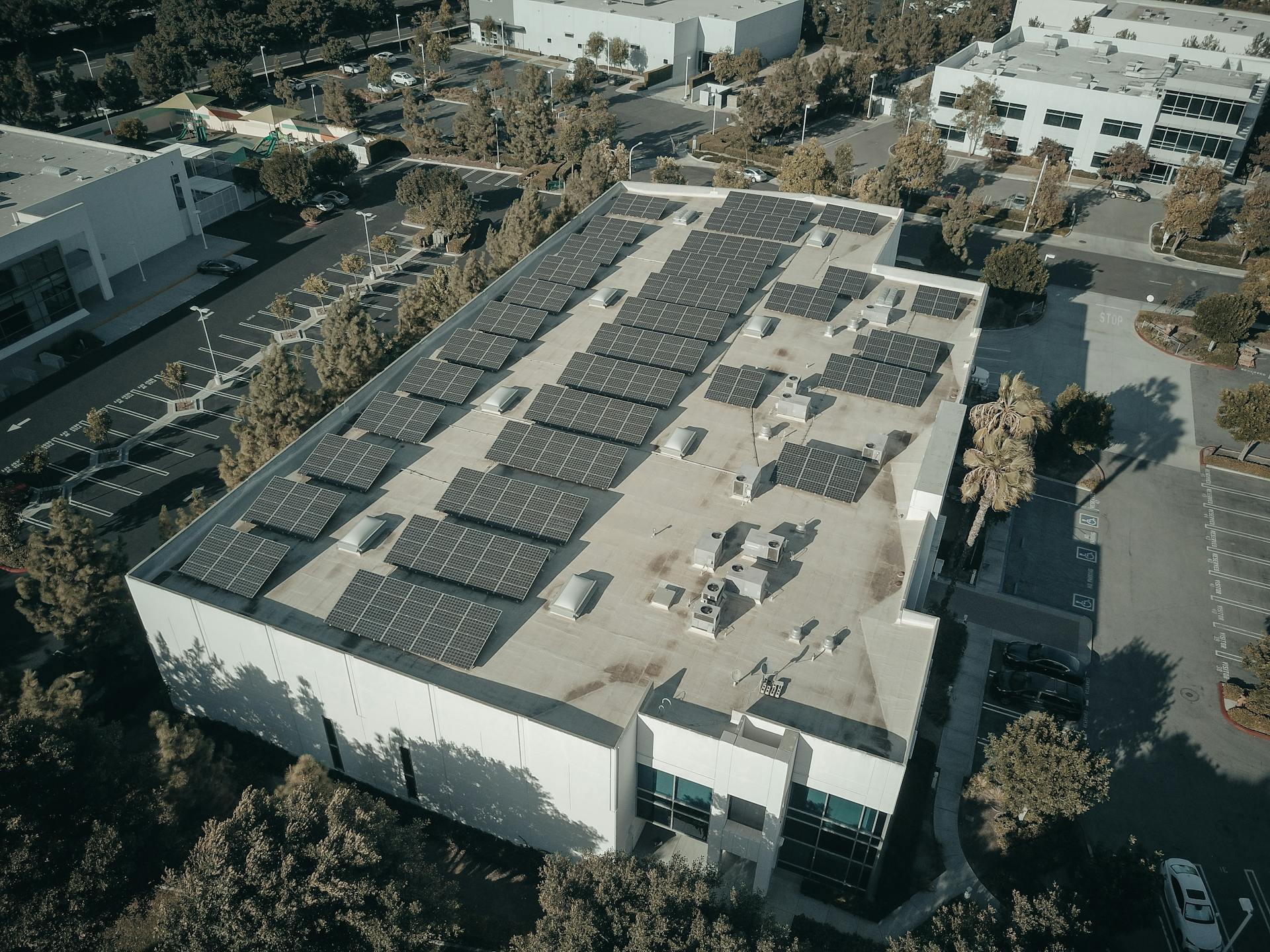
Commercial property insurance rating factors can be complex, but understanding the key factors can help you make informed decisions. The size of your property is a major factor, with larger properties typically costing more to insure.
Location is also a crucial consideration, with properties in high-risk areas such as flood zones or areas prone to natural disasters costing more to insure. The type of construction and materials used in your building can also impact premiums, with buildings made of fire-resistant materials often costing less.
The value of the property itself is another key factor, with more valuable properties typically requiring higher premiums. The type of business you operate can also influence premiums, with businesses that store hazardous materials or have a high risk of theft costing more to insure.
Related reading: Can I Deduct Life Insurance Premiums as a Business Expense
Commercial Property Insurance Basics
Commercial property insurance is used to cover any commercial property, protecting it from perils like fire, theft, and natural disasters. It's a critical aspect of business insurance that many types of businesses, including manufacturers, retailers, and service-oriented businesses, carry.
Commercial property insurance can be broken down into two types of coverages: business building insurance and business contents insurance. Business building insurance covers the structure and permanently installed items, while business contents insurance covers business property stored on or near the premises, such as inventory and equipment.
The core coverages provided by commercial property insurance include buildings and structures, contents, fences, signs, and landscaping. These coverages can be customized to fit the specific needs of your business, and an independent insurance agent can help you understand the basic coverages and how they'll benefit your business.
What is?
Commercial property insurance is a type of insurance that protects business property from various threats, including fire, theft, and natural disasters. It's a must-have for any business, regardless of its size or type.
There are three different levels of commercial property coverage, each providing varying degrees of protection against different causes of damage or loss. Basic form policies cover damage from common causes like fire, windstorms, and vandalism, while broad form policies add coverage for damage from leaking appliances and structural collapses. Special form policies, on the other hand, provide the most comprehensive coverage, excluding only those causes specifically listed in the policy.
For another approach, see: What Does Workmen Compensation Insurance Cover
Commercial property insurance can be broken down into two main types of coverages: business building insurance and business contents insurance. Business building insurance protects the physical structure of your business, while business contents insurance covers the contents inside, such as inventory, furniture, and equipment.
Some common coverages that can be added to a commercial property insurance policy include business interruption coverage, which pays for lost income if your business is unable to operate; extra expense coverage, which pays for additional costs to return your business to normal after a disaster; and valuable papers coverage, which provides limited coverage for business records and other valuable papers.
Here are some of the core coverages provided by commercial property insurance:
- Buildings and structures: Can be insured for their replacement value or actual cash value
- Contents: Includes business property stored on or near the business premises, used for the business's operations
- Fences, signs, and landscaping: May be automatically covered, but limits can be increased
- Property in your care: Covers property belonging to others that is in your care, custody, and control
- Customers' personal property: Protects personal property belonging to customers while they are on your business premises, and in some cases, when they are away from your premises.
Commercial property insurance is a critical aspect of business insurance, and it's essential to have the right protection for your business's property. An independent insurance agent can help your business get set up with the policy that works best for your needs.
Other Business Types
Many businesses, such as restaurants and retail stores, are vulnerable to theft and vandalism, making crime insurance coverage a crucial aspect of their commercial property insurance policy.
If a business is forced to close temporarily due to a covered event, business interruption insurance can help cover ongoing expenses, such as rent and employee salaries.
Some businesses, like those in the construction industry, may require specialized equipment insurance to protect their valuable tools and machinery.
For businesses with a high volume of customers, liability insurance can provide protection against claims of bodily injury or property damage.
Rating Factors
Commercial property insurance rates are influenced by various factors, including location, construction, and occupancy. Buildings in cities or towns with excellent fire protection typically cost less to insure than those outside a city or in areas with limited fire protection.
Construction is another critical factor, with buildings made of potentially combustible materials having higher premiums. On the other hand, those made of fire-resistant materials could earn a discount. Internal structural elements can also change a fire rating, so it's essential to consider these factors when remodeling.
Check this out: Commercial Fire Insurance Claim
Occupancy is also a significant factor, with a building's use affecting its fire rating. An office building will likely rate better than a restaurant or auto repair shop. In a building with multiple tenants, one hazardous occupant will negatively affect the fire rating of the entire building.
Here are some factors that can impact a building's fire rating:
- Building materials
- Adjacent exposures
- Proximity to a fire station
- The building's sprinkler system (or lack of)
These factors can result in higher premiums or a lower fire rating, which can affect the cost of commercial property insurance. By understanding these factors, businesses can take steps to reduce their insurance costs and ensure they have adequate coverage.
Premium Calculation
The premium for building and personal property under Group I is developed individually using a specific formula. This formula takes into account various factors such as loss cost, company loss cost multiplier, territory multiplier, coinsurance factor, and limit of insurance relativity factor.
Here's a step-by-step breakdown of the premium calculation process:
This formula is applied to each property type separately, resulting in a unique premium for building and personal property.
Group I Formula
The Group I formula is used to calculate premiums for losses caused by fire, lightning, explosion, vandalism, and sprinkler leakage. This formula is applied to both building and personal property.
There are six steps to the Group I formula, starting with determining the Group I loss cost based on the CSP Class code or specific rate. This loss cost is then multiplied by the company loss cost multiplier (LCM) to develop a rate.
If the risk is class rated, the rate is multiplied by the territory multiplier, which is 1.00 if the risk is not class rated. This is a crucial step, as it affects the final rate.
The next step is to multiply the rate by the applicable coinsurance factor. This factor is 0.95 for building and 1.00 for personal property, as seen in Charlie's example.
The final rate is then multiplied by the Limit of Insurance Relativity Factor to develop the final rate. This factor is 0.969 for building and 1.059 for personal property.
Recommended read: California Insurance Department Rate Filings
The Group I premium is then calculated by multiplying the final rate by the limit of insurance per $100. For example, Charlie's building has a limit of insurance of $300,000, and his personal property has a limit of insurance of $35,000.
Here's a summary of the Group I formula steps:
The Group I premium is then calculated by multiplying the final rate by the limit of insurance per $100.
Group II Formula
Group II Formula is a key concept in premium calculation. It's used to determine the premium for a policy with a high risk factor.
The Group II Formula considers the age of the policyholder, with older individuals paying higher premiums. This is because older individuals are more likely to file claims.
The formula also takes into account the policy's coverage limits, deductibles, and other factors that affect the risk level. For example, a policy with a lower deductible may have a higher premium.
A policyholder's medical history can also impact the premium, with those who have a history of costly medical conditions paying more. This is because the policyholder is considered higher risk.
Broaden your view: Nationwide Pet Insurance Major Medical Plan
Policy Details
Policy Details are crucial when it comes to understanding how commercial property insurance works.
Commercial property insurance typically covers buildings and structures for their replacement value or actual cash value, including permanently installed items like fixtures and machinery.
You can increase the limits on coverage for outdoor signs, fences, and landscaping if needed.
If a business is responsible for property belonging to others, commercial property insurance can cover it from many perils.
This type of insurance also protects customers' personal property while they're on your business premises.
You might enjoy: Progressive Total Loss Coverage vs Actual Cash Value
Policy Options
There are three main levels of commercial property coverage to choose from. Each level provides varying degrees of protection against different causes of damage or loss.
Basic form policies are the most limited, covering damage from common causes like fire, windstorms, and vandalism. They're often a good starting point for businesses with minimal assets or risks.
Broad form policies expand on basic form coverage, adding protection for damage from leaking appliances, structural collapses, and weight of ice or snow. This level of coverage is suitable for businesses with moderate assets or risks.
On a similar theme: Level Term 20 Life Insurance
Special form policies offer the most comprehensive coverage, protecting against all causes of loss except those specifically listed in the policy. These policies are ideal for businesses with significant assets or high-risk operations.
Here's a quick comparison of the three policy levels:
Understanding Commercial Property Insurance
Commercial property insurance can be a major expense for businesses, especially those with valuable equipment worth millions or billions of dollars.
The value of a business' assets, including the building, is the primary factor in determining how much to pay for commercial property insurance.
Businesses can usually deduct the cost of commercial property insurance premiums as expenses, which can be a significant advantage.
Before purchasing commercial property insurance, take an inventory of your physical assets located at your property to determine the replacement value and necessary level of coverage.
Properties located in areas prone to natural disasters, such as wildfires in California, have higher commercial insurance rates due to the increased risk of weather-related catastrophes.
Commercial property insurance generally does not cover losses arising from tenants using the building, so it's essential to consider this when determining coverage.
You might enjoy: What Does Apartment Insurance Cover
Sources
- http://rnc-advantageplus.com/rnc-advantageplus/pfm/100/130_0502.HTM
- https://www.investopedia.com/terms/c/commercial-property-insurance.asp
- https://www.tdi.texas.gov/pubs/consumer/cb021.html
- https://www.thimble.com/commercial-property-insurance
- https://www.trustedchoice.com/business-insurance/coverage-types/commercial-property/
Featured Images: pexels.com


